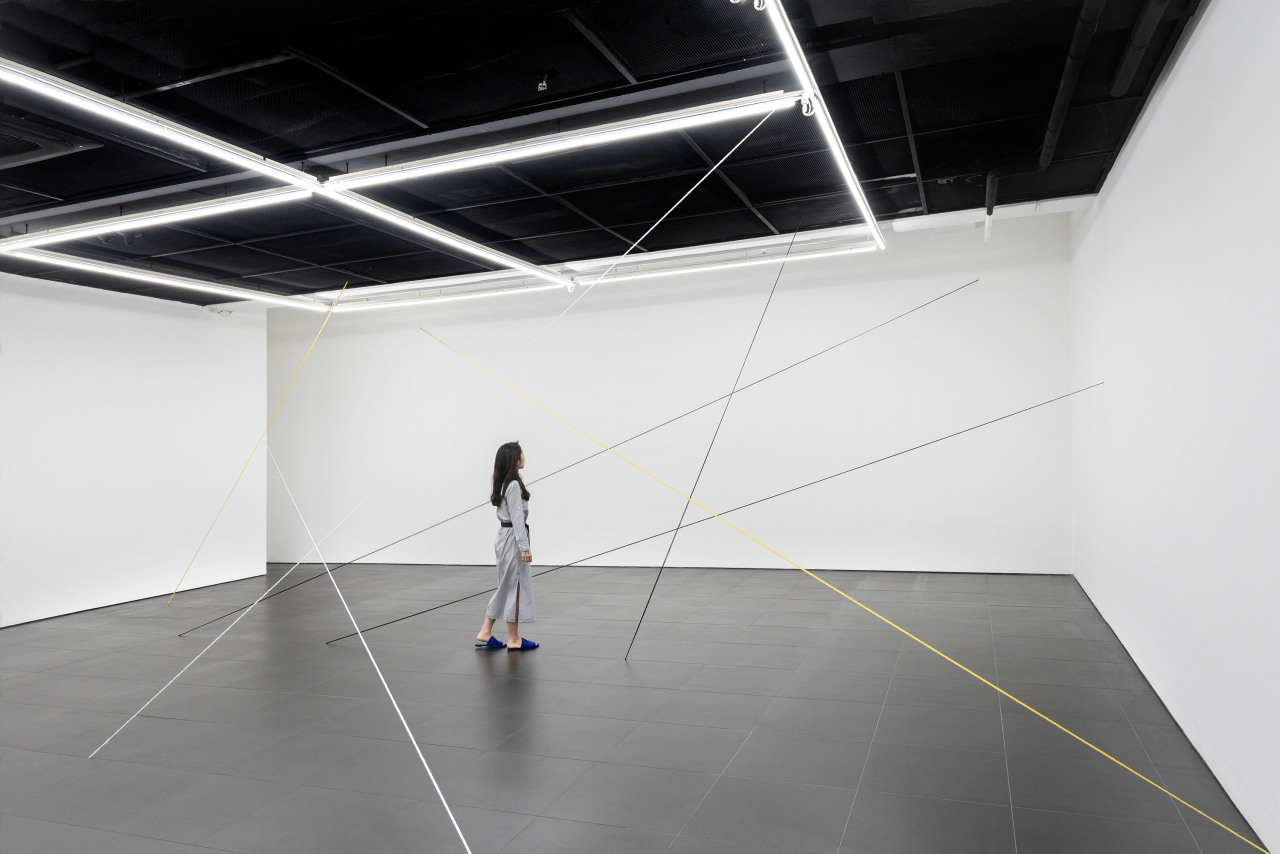Tautly stretched lines in different colors form geometric shapes in and outside of the gallery space. They extend from the basement all the way to the high ceiling of the upper floor. Some lines define quadrangles that are leaning against a wall, while others come out from one wall just to meet another.
 |
A visitor walks between Fred Sandback’s sculpture “Untitled (Sculptural Study, Seven-part Construction)” from his ““Pick-up Stick” series from the 1990s. (Gallery Hyundai) |
The sculptures, made of yarn, appear lightweight. In terms of visual presence too, they are “barely there.” But the yarn sculptures are visually intriguing, after all.
Gallery Hyundai is holding a solo exhibition of the late Fred Sandback, a representative US postwar sculptor who created minimalist sculptures from elastic cords or yarn. Yet Sandback stands out from from his minimalist contemporaries who used opaque, glossy and glamorous materials.
The latest exhibition at Gallery Hyundai introduces 29 pieces by Sandback, including sculptures, drawings and prints, ranging from the work he made when he was a graduate student at Yale in 1968 to more recent works.
The exhibition, titled “Fred Sandback: Obangsaek,” also features yarn sculptures that represent the five cardinal colors in Korean traditional culture.
“The title was an idea suggested by Sandback’s family, to celebrate the exhibition in Korea,” a gallery official said during a press conference held Friday at Gallery Hyundai, located in the Samcheong-dong area of Seoul.
Here as in other Sandback exhibitions, the sculptures have been installed in accordance with the instructions and diagrams that Sandback left, which detail the sculptures’ configurations, measurements and ratios, along with specifications for the types and colors of cords to use. The works have been installed under the direction of the artist’s estate, the gallery added.
The exhibition starts with the first floor, which includes a large sculpture made with black yarn, “Untitled (Sculptural Study, Six-part Right-angled Construction).” This large work made of L-shaped lines forms a shape like three gates standing back to back, with space in between that an adult can walk through.
The space is called “pedestrian space,” a term coined by Sandback to refer to the space he creates, where the performative role of visitors plays an important part, according to the gallery.
In Sandback’s “pedestrian space,” the sculptures subtly direct the movement of visitors, and the visitors are in turn to walk right through the sculptures or pass by, instead of just looking at the piece from one spot. Visitors are to move around and look at the string sculptures from different angles and see how they appear different.
The gallery said his works are, for the most part, not referential. They don’t stand in the exhibition space as separate entities like other artworks hung on museum walls. Instead, their purpose is to shape the space so as to allow visual experience.
The exhibition also showcases some Sandback sculptures that have not been previously displayed. One is the pentagonal work “Untitled (Broken Line Polygon),” made with white yarn that has been painted with yellow and black acrylic paint.
When an exhibition ends, the materials used for Sandback’s works are usually discarded.
But this particular yarn, which the artist colored himself, has to be returned to the family intact because it is the one and only material used for the piece.
 |
A view of Fred Sandback’s installation work on Dugahun, a restaurant behind Hyundai Gallery. (Gallery Hyundai) |
In the gallery, visitors can encounter different variations of lines stretching between the floor and the ceiling, to and from different points on the walls and across corners.
Shown in the basement are sculptures from the artist’s playful “Pick-up Stick” series from the 1990s. Sandback’s works are also shown outside of Dugahun, a restaurant behind the gallery.
The exhibition runs through Oct. 6.
By Shim Woo-hyun (
ws@heraldcorp.com)









![[Today’s K-pop] Blackpink’s Jennie, Lisa invited to Coachella as solo acts](http://res.heraldm.com/phpwas/restmb_idxmake.php?idx=644&simg=/content/image/2024/11/21/20241121050099_0.jpg)